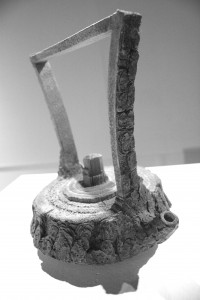Yixing in America

Joe Douglas
– Jr. Copy Editor-
Soup cans are art, metal coat hangers are art, and sculptures of people without arms are art. Even teapots can be art. After all, anything can be art, and the Meramec Contemporary Art Gallery will prove just that.
STLCC–Meramec will be featuring eastern and western-style sculptures reflecting the traditional Yixing approach, a Chinese art based on forms and animals in nature, turned contemporary. The event: “Inspired: Exploring the Yixing Sensibility.”
“This is [our] first experience having someone with Yixing experience here,” James Ibur, head of ceramics in the art department at Meramec, said. “The craftsmanship is insane; it’s crazy cool.”
From Aug. 28 to Sept. 25, Meramec’s art gallery in Humanities East will be hosting the ceramic works of Junya Shao, famous for her contemporary approach to the Yixing style, and will be visiting Meramec on Sept. 16 and 17.
“Junya is a new-generation potter,” Ibur said.
Twelve artists who follow in her artistic style will also be featuring their own Yixing-style works, including Meramec Student Jimmy Liu.
“I have over 200 works on my website,” Liu said. Liu has won two Best of Show awards: one in Phoenix, Ariz. and one in Quincy, Ill. Liu’s Yixing-style teapots are free for viewing on flickr.com/photos/jimmyliu.
The Yixing style dates back to the Song Dynasty of 10th century ancient China when a monk who was making tea in a teapot discovered that, without placing a single tea leaf in the pot, he already had tea.
The secret was a unique clay called zisha, meaning “purple sand,” found only in Yixing, China. The zisha clay is unique with its property to absorb the flavor of tea brewed in it, making each subsequent batch of tea more rich and enhanced. Over many uses, pouring boiling water into an empty zisha pot can actually create tea because of the amount of flavor stored in it over time.
Today, these seemingly magic zisha teapots are sought after by tea connoisseurs from around the world, making them highly valuable and rare.
The value of these teapots can range from hundreds to thousands of dollars. Due to the value of the pieces that will be on display, this is a no-touching exhibit.
“As much as you’d like to touch, don’t do it,” Ibur said.
Admission to the event is free. Exhibit hours are: 9 a.m. to 8 p.m. Monday through Thursday; 9 a.m. to 4 p.m. on Fridays; and 10 a.m. to 4 p.m. on Saturdays. The exhibit is closed on all Sundays and holidays.
“This is going to be an amazing show and be intense for its small size,” Ibur said.











